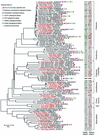Diversity of bacterial populations on the tongue dorsa of patients with halitosis and healthy patients
- PMID: 12574246
- PMCID: PMC149706
- DOI: 10.1128/JCM.41.2.558-563.2003
Diversity of bacterial populations on the tongue dorsa of patients with halitosis and healthy patients
Abstract
The primary purpose of the present study was to compare the microbial profiles of the tongue dorsa of healthy subjects and subjects with halitosis by using culture-independent molecular methods. Our overall goal was to determine the bacterial diversity on the surface of the tongue dorsum as part of our ongoing efforts to identify all cultivable and not-yet-cultivated species of the oral cavity. Tongue dorsum scrapings were analyzed from healthy subjects with no complaints of halitosis and subjects with halitosis, defined as an organoleptic score of 2 or more and volatile sulfur compound levels greater than 200 ppb. 16S rRNA genes from DNA isolated from tongue dorsum scrapings were amplified by PCR with universally conserved bacterial primers and cloned into Escherichia coli. Typically, 50 to 100 clones were analyzed from each subject. Fifty-one strains isolated from the tongue dorsa of healthy subjects were also analyzed. Partial sequences of approximately 500 bases of cloned inserts from the 16S rRNA genes of isolates were compared with sequences of known species or phylotypes to determine species identity or closest relatives. Nearly complete sequences of about 1,500 bases were obtained for potentially novel species or phylotypes. In an analysis of approximately 750 clones, 92 different bacterial species were identified. About half of the clones were identified as phylotypes, of which 29 were novel to the tongue microbiota. Fifty-one of the 92 species or phylotypes were detected in more than one subject. Those species most associated with healthy subjects were Streptococcus salivarius, Rothia mucilaginosa, and an uncharacterized species of Eubacterium (strain FTB41). Streptococcus salivarius was the predominant species in healthy subjects, as it represented 12 to 40% of the total clones analyzed from each healthy subject. Overall, the predominant microbiota on the tongue dorsa of healthy subjects was different from that on the tongue dorsa of subjects with halitosis. Those species most associated with halitosis were Atopobium parvulum, a phylotype (clone BS095) of Dialister, Eubacterium sulci, a phylotype (clone DR034) of the uncultivated phylum TM7, Solobacterium moorei, and a phylotype (clone BW009) of STREPTOCOCCUS: On the basis of our ongoing efforts to obtain full 16S rRNA sequences for all cultivable and not-yet-cultivated species that colonize the oral cavity, there are now over 600 species.
Figures

Similar articles
-
Molecular identification of bacteria on the tongue dorsum of subjects with and without halitosis.Oral Dis. 2008 Apr;14(3):251-8. doi: 10.1111/j.1601-0825.2007.01371.x. Oral Dis. 2008. PMID: 18336372
-
Identification of oral bacterial species associated with halitosis.J Am Dent Assoc. 2007 Aug;138(8):1113-20. doi: 10.14219/jada.archive.2007.0325. J Am Dent Assoc. 2007. PMID: 17670880
-
Bacterial diversity in human subgingival plaque.J Bacteriol. 2001 Jun;183(12):3770-83. doi: 10.1128/JB.183.12.3770-3783.2001. J Bacteriol. 2001. PMID: 11371542 Free PMC article.
-
The relationship between oral malodor and volatile sulfur compound-producing bacteria.Otolaryngol Head Neck Surg. 2006 Nov;135(5):671-6. doi: 10.1016/j.otohns.2005.09.036. Otolaryngol Head Neck Surg. 2006. PMID: 17071291 Review.
-
The rationale and potential for the reduction of oral malodour using Streptococcus salivarius probiotics.Oral Dis. 2005;11 Suppl 1:29-31. doi: 10.1111/j.1601-0825.2005.01084.x. Oral Dis. 2005. PMID: 15752094 Review.
Cited by
-
Bugs that debugs: Probiotics.J Pharm Bioallied Sci. 2012 Aug;4(Suppl 2):S319-22. doi: 10.4103/0975-7406.100286. J Pharm Bioallied Sci. 2012. PMID: 23066281 Free PMC article.
-
As-yet-uncultivated oral bacteria: breadth and association with oral and extra-oral diseases.J Oral Microbiol. 2013 May 23;5. doi: 10.3402/jom.v5i0.21077. Print 2013. J Oral Microbiol. 2013. PMID: 23717756 Free PMC article.
-
Bacterial biogeography of the human digestive tract.Sci Rep. 2011;1:170. doi: 10.1038/srep00170. Epub 2011 Nov 25. Sci Rep. 2011. PMID: 22355685 Free PMC article.
-
Halitosis in otorhinolaryngology practice.Iran J Otorhinolaryngol. 2015 Mar;27(79):145-53. Iran J Otorhinolaryngol. 2015. PMID: 25938086 Free PMC article. Review.
-
The Mechanisms of Probiotics, Prebiotics, Synbiotics, and Postbiotics in Oral Cancer Management.Probiotics Antimicrob Proteins. 2023 Oct;15(5):1298-1311. doi: 10.1007/s12602-022-09985-7. Epub 2022 Sep 1. Probiotics Antimicrob Proteins. 2023. PMID: 36048406 Free PMC article. Review.
References
-
- Bosy, A., G. V. Kulkarni, M. Rosenberg, and C. A. McCulloch. 1994. Relationship of oral malodor to periodontitis: evidence of independence in discrete subpopulations. J. Periodontol. 65:37-46. - PubMed
-
- De Boever, E. H., M. DeUzeda, and W. J. Loesche. 1994. Relationship between volatile sulfur compounds, BANA-hydrolyzing bacteria and gingival health in patients with and without complaints of oral malodor. J. Clin. Dent. 4:114-119. - PubMed
-
- De Boever, E. H., and W. J. Loesche. 1995. Assessing the contribution of anaerobic microflora of the tongue to oral malodor J. Am. Dent. Assoc. 126:1384-1393. - PubMed
Publication types
MeSH terms
Grants and funding
LinkOut - more resources
Full Text Sources
Other Literature Sources
Medical
Molecular Biology Databases

